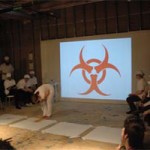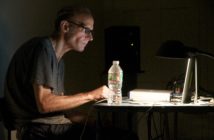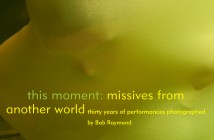By JED SPEARE
It has been noted here in past pages by Natalie Loveless that a regeneration of performance art is taking place in Boston. Artists and organizers such as Test Performance Art Event and The Present Tense formed their own collective entities and have been producing events in Boston for the past three years. Contaminate II, a festival featuring 16 artists, held at the unfinished "café" space of the redeveloped, post-industrial Midway Studios, March 9th and 10th, was such a joint venture. Their productions must be welcomed and attended given the dearth of alternative spaces with live art programs in Boston. Programming in unusual spaces has become a desirable and expeditious strategy, in and of itself, for groups and organizations to get their mission across and to realize their work on its own terms. Test’s and Present Tense’s do-it-yourself approach is refreshing and necessary, both as a testament to the nature of performance art and their need to purvey it.
My thoughts after this festival have been focused on reminding myself (to myself, changing) and reaffirming what performance art is for me, as an act of renewal for performer and audience, ritually attended, through what the many works brought up in their ludic (playful) ways. The many strands or styles that embodied and underpinned formal, personal, and socio-cultural essences and references; qualities that reminded me that performance is at least, in part, real action in real time, and that my senses, thoughts, and emotions could be awakened, challenged, and transformed in unexpected ways. It is upon the performer and viewer to have an exchange in experience (or not), and that this is what constructs impressions, impacts, and meanings for oneself that may then be shared and extrapolated for an audience and hence, a culture. So too in practice, in the context of Contaminate II, the artists' proximity and access to the audience also led to post-performance discussions that at their heart, and as a by-product of this interaction, extended the performance, artist, and audience member into new realms of understanding about the work, This is important as a part of the culture of performance art that sustains a human ecology for the morphology and continuation of the entire experience. It is not that this may be very different from the way an art event engages us, in its clusters of post-conversations, but rather that it seems these dialogues must naturally occur with performance art, on-site and with a certain urgency, as an imperative to remembering what has temporally transpired.
One of the ways that the festival was most affecting and memorable was that each artist’s performance area was uniquely sited within the slightly obtuse, columnar space. For each artist’s own interaction and activation upon and within their given space, the variable and limited performance perimeters created by the spacial definitions for their works were extremely successful. The space, through the performer’s figure and actions, is articulated as the sanctuary and vehicle for their enactments, as each artist must create their own scale and intimacy to contain and fully manifest the proportions of their actions. This sense was especially evident in the works of Julia Handschuh, Ian Colon, Francis Arguin, Kid Epicene (Helen Pfann), Martine Viale, Alice Vogler, Elvira Santamaria, Andi Sutton and Catherine D'Ignazio.
I noticed this first in the work of Kid Epicene (Helen Pfann), where the simple action of swiftly slapping her body in the transitional intervals between the various actions, leading to her transformation into and embodiment of a male figure, acoustically electrified and defined her space. It seemed like an unplanned and even somewhat uncertain action, yet for me it reinforced the physicality of the metamorphosis she undertook. Beginning with applying mascara to her facial hair, accentuating it, to drinking beer, cooking a steak, rolling in ketchup and plastic tarp, this was a visceral exploration and denouement of redneck masculinity.
Sometimes, as a viewer, the quirks and unexpected things during performances seem unintended, yet carry the most resonant intentions. This was my impression of Ian Colon’s piece, Hooker and John. The low-tech television monitor that he carried belovedly, walking and then running in a circle, was plugged in with an extension cord to an outlet from the ceiling. A wireless camera was fastened to the back of his head of hair, so he had a rear-view image of the audience in the monitor as he stepped up his pace. The labor of carrying the monitor, and the ensuing entanglement of the extension and monitor cables, led to these devices unplugging a few times, forcing Colon to stop and reset himself and the gear, protracting the entropy of his action. It was in these delays, occurring in the process of the inevitable exhaustion he experienced, that the imagery of an unending departure, of personal entanglements he could not escape was essentially expressed: his relation to the monitor and to the mediated audience was literally and terminally bound.
Material extensions of the body were prevalent through several of the works in the festival. Could one draw a straight line historically from Bauhausian slat-dances and Futurist/Dada aerophones and megaphones to the work of Francis Arguin, Julia Handschuh, and Martine Viale? Perhaps, but performance seems always new in its cultural and chronological context. Arguin, from Quebec, presented perhaps the most episodic and developed work of the festival, unfolding in several actions and extensions of feet and fingers, culminating in his quadrupedal exit on top of four small "wheels", moving and rolling forward one limb at a time. This gesture, in its humbling of the performer, became an emboldening, triumphant feat in its execution. Martine Viale, also from Quebec, presented Elongation, a work that was also physically demanding, stepping from one bowl of blue paint to the next. Her strong presence and ability was intentionally challenged, not always able to move each foot precisely from bowl to bowl within, as the traces of paint she left below appeared like waters around islands. At the end, she sat and puffed a fog of gold dust, that for me evoked a metaphysical "cloud of unknowing." Julia Handschuh’s Disquieted, of breaths and vocal sounds articulated through a large, welded, sculptural metal cone pointed upwards, extended her voice acoustically with minimal amplification. Her position beneath the cone suggested both supplication and subjugation.
Alice Vogler took the physicality and functions of the body one step further. Her Bio Sponse Test 1, was a serio-comic game, involving audience contestants who cleaned the blood, urine, and vomit she produced (performed) and deposited consecutively. Following the instructions of an actual bio-hazard kit, the contestants were also evaluated by selected audience members who astutely and idiosyncratically commented, awarding a prize to the most capable contestant. Vogler’s expression of her body and the careful carrying out of the cleanups with the compact kits, underscored an entire industry that has emerged in an age of institutionalized fear of contamination.
Elvira Santamaria, from Mexico, concluded the festival with Been Here. She began by posting on a wall the day's front page of the Boston Globe, with its sub-headline to set your clocks forward. Pacing away from the wall, and laying out twelve plums, she rehearsed the action, like a pitcher warming up, preparing her for throwing each plum at the newspaper. After each rehearsal came the actual release, scattering the plums as the hours of a clock. Cutting and then affixing the newspaper’s words to each plum, a new, calm order was gently claimed: time could be haywire, as subjectively dispersed, but always there in measure.
Contaminate II was most like this, appearing and disappearing over two nights, in phantom memories, apparitions, and temperaments to me now. The mixture of Boston-based and visiting artists, more than I will individually comment on here, yielded a variety of styles and endeavors in a setting rough enough to match the character of the work. Festivals can be exhausting, too much to completely take in, and fleeting in transience; yet to be a festival there must be numerous works promulgated as a critical mass, and in that I left, contaminated, wondering about the next infestation.
But wait - after the final announcements were made a voice bellowed from the audience, that of newly-appointed "radical jester" Milan Kohout, asking us to sing Happy Birthday to someone turning 50 that day. As we all obliged, and at the final cadence, we had to laugh when Kohout boisterously interjected "Osama Bin Laden" as the birthday-boy, beneficiary of our song...
- Alice Vogler, Bio Sponse Test 1. Photo by Vela Phelan.
- Francis Arguin, Attempts on balance. Photo by Vela Phelan.
- Martine Viale, Elongation. Photo by Vela Phelan.
"Contaminate II Festival of Performance Art" is on view March 9, 10, 2007 at Midway Studios in Fort Point, Boston.
All images are courtesy of the artists and Midway Studios.
Photos by Vela Phelan.







